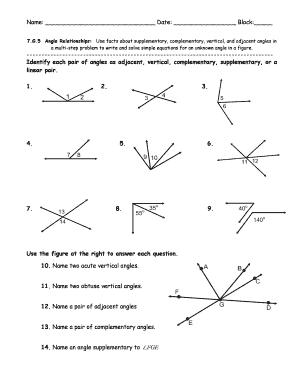
Identify Each Pair of Angles as Adjacent Vertical Complementary Supplementary Form


Understanding Complementary, Supplementary, and Vertical Angles
Complementary angles are two angles whose measures add up to ninety degrees. For example, if one angle measures thirty degrees, the other must measure sixty degrees to be complementary. Supplementary angles, on the other hand, are two angles whose measures add up to one hundred eighty degrees. An example of this would be a one hundred degree angle paired with an eighty degree angle. Vertical angles are formed when two lines intersect, creating two pairs of opposite angles that are equal in measure. Understanding these definitions is crucial for identifying and working with angles in various mathematical contexts.
Identifying Each Pair of Angles
To identify pairs of angles as adjacent, vertical, complementary, or supplementary, start by analyzing their positions relative to one another. Adjacent angles share a common side and vertex but do not overlap. Vertical angles are opposite each other when two lines intersect. To determine if angles are complementary, check if their measures add up to ninety degrees. For supplementary angles, ensure their measures total one hundred eighty degrees. This systematic approach will help in accurately categorizing the angles.
Examples of Angle Identification
Consider two angles measuring forty degrees and fifty degrees. These angles are complementary because their sum equals ninety degrees. If you have an angle measuring one hundred degrees and another measuring eighty degrees, these angles are supplementary since their sum equals one hundred eighty degrees. In a scenario where two lines intersect, the angles formed are vertical angles, and they will be equal in measure. By practicing with various examples, one can become proficient in identifying and classifying angles.
Legal Use of Angle Identification in Documentation
When documenting findings related to angles, especially in educational or professional settings, it is important to ensure accuracy in your classifications. Mislabeling angles can lead to misunderstandings in mathematical proofs or engineering designs. In the United States, maintaining clarity and precision in documentation is essential for compliance with educational standards and professional guidelines. Properly identifying angles as complementary, supplementary, or vertical can enhance the integrity of your work.
Steps to Complete Angle Identification Worksheets
To effectively complete worksheets that involve identifying complementary, supplementary, and vertical angles, follow these steps: First, review the definitions of each type of angle. Next, examine the diagrams provided in the worksheet. Use a protractor if necessary to measure angles accurately. Then, classify each pair of angles based on their relationships. Finally, double-check your answers to ensure they align with the definitions. This structured approach will help in mastering angle identification.
Quick guide on how to complete adjacent complementary angles
Effortlessly Prepare adjacent complementary angles on Any Device
Digital document management has become increasingly favored by organizations and individuals alike. It offers a superb eco-friendly substitute for traditional printed and signed paperwork, allowing you to access the appropriate form and securely store it online. airSlate SignNow provides you with all the tools necessary to create, modify, and electronically sign your documents swiftly without any hold-ups. Handle complementary supplementary and vertical angles across any platform with the airSlate SignNow apps for Android or iOS and enhance any document-centric process today.
The simplest way to alter and electronically sign vertical complementary and supplementary angles worksheet effortlessly
- Find complementary supplementary and vertical angles worksheet pdf and click on Get Form to begin.
- Utilize the tools we offer to fill out your document.
- Select important sections of the documents or obscure sensitive information with tools specifically designed for that purpose by airSlate SignNow.
- Create your eSignature using the Sign tool, which takes moments and carries the same legal validity as a conventional wet ink signature.
- Review the information and click on the Done button to save your modifications.
- Choose how you want to share your form, whether via email, SMS, invitation link, or download it to your computer.
Eliminate worries about lost or misplaced files, tiresome form searches, or mistakes that necessitate printing new copies of documents. airSlate SignNow meets your document management needs in just a few clicks from your preferred device. Alter and electronically sign complementary supplementary vertical and adjacent angles and guarantee excellent communication at every phase of the form preparation process with airSlate SignNow.
Create this form in 5 minutes or less
Related searches to angles complementary supplementary and vertical
Create this form in 5 minutes!
How to create an eSignature for the vertical adjacent complementary and supplementary angles
How to create an electronic signature for a PDF online
How to create an electronic signature for a PDF in Google Chrome
How to create an e-signature for signing PDFs in Gmail
How to create an e-signature right from your smartphone
How to create an e-signature for a PDF on iOS
How to create an e-signature for a PDF on Android
People also ask adjacent vs vertical angles
-
What are complementary supplementary and vertical angles?
Complementary supplementary and vertical angles are concepts in geometry that describe the relationships between angles. Complementary angles add up to 90 degrees, supplementary angles sum to 180 degrees, and vertical angles are opposite angles formed by intersecting lines. Understanding these definitions is crucial for various applications in design and mathematics.
-
How does airSlate SignNow support documents that involve complementary supplementary and vertical angles?
AirSlate SignNow allows users to create, send, and eSign documents related to educational materials that cover complementary supplementary and vertical angles. Our platform makes it easy to incorporate diagrams and explanations directly into your documents, ensuring clear communication of these concepts. This functionality is invaluable for teachers and students alike.
-
Are there any specific templates related to angle calculations in airSlate SignNow?
Yes, airSlate SignNow provides several templates that can be customized to include information on complementary supplementary and vertical angles. You can easily create educational resources or contracts that explain these concepts while also facilitating electronic signatures. This feature enhances productivity and streamlines documentation processes.
-
What are the pricing options for airSlate SignNow?
AirSlate SignNow offers flexible pricing options that cater to different user needs, whether you are an individual educator or part of a larger institution. Our plans are competitively priced, providing comprehensive features for managing documents like those involving complementary supplementary and vertical angles. This cost-effective solution ensures you get great value without compromising on essentials.
-
Can I integrate airSlate SignNow with other educational tools?
Absolutely! AirSlate SignNow offers seamless integrations with a variety of educational tools and software. Whether you're using platforms for teaching geometry or other subjects that involve concepts like complementary supplementary and vertical angles, our integrations make it easier to manage all your documents in one place.
-
What benefits does airSlate SignNow provide for teachers dealing with angles?
AirSlate SignNow enhances the teaching experience by facilitating hassle-free document management related to topics like complementary supplementary and vertical angles. With our easy-to-use eSigning capabilities, teachers can efficiently send assignments, quizzes, and educational materials for review and signatures. This saves time and streamlines the educational process.
-
Is it secure to eSign documents related to geometry topics on airSlate SignNow?
Yes, security is a top priority at airSlate SignNow. Our platform uses advanced encryption and security protocols to ensure that all documents signed, including those discussing complementary supplementary and vertical angles, are completely safe and protected. You can trust our service for secure document handling.
Get more for supplementary complementary vertical and adjacent angles
- Laverty doctors stock order form
- Patient safety incident management amp reporting form part htintan moh gov
- Guardian visa malaysia form
- Application for employee parking parking port of seattle portseattle form
- Surety bond format
- 1021 form 5427309
- Work power and energy worksheet form
- Hoa nomination form
Find out other identify complementary supplementary vertical and adjacent angles
- How To eSignature Kansas CV Form Template
- eSignature Iowa CV Form Template Simple
- How Do I eSignature Kansas CV Form Template
- Help Me With eSignature Kansas CV Form Template
- How Can I eSignature Kansas CV Form Template
- eSignature Iowa CV Form Template Easy
- Can I eSignature Kansas CV Form Template
- eSignature Iowa CV Form Template Safe
- eSignature Kentucky CV Form Template Online
- eSignature Kentucky CV Form Template Computer
- eSignature Kentucky CV Form Template Mobile
- How To eSignature Kentucky CV Form Template
- eSignature Kentucky CV Form Template Now
- eSignature Kentucky CV Form Template Later
- eSignature Kentucky CV Form Template Myself
- eSignature Kentucky CV Form Template Free
- How Do I eSignature Kentucky CV Form Template
- eSignature Louisiana CV Form Template Online
- eSignature Kentucky CV Form Template Secure
- eSignature Kentucky CV Form Template Fast